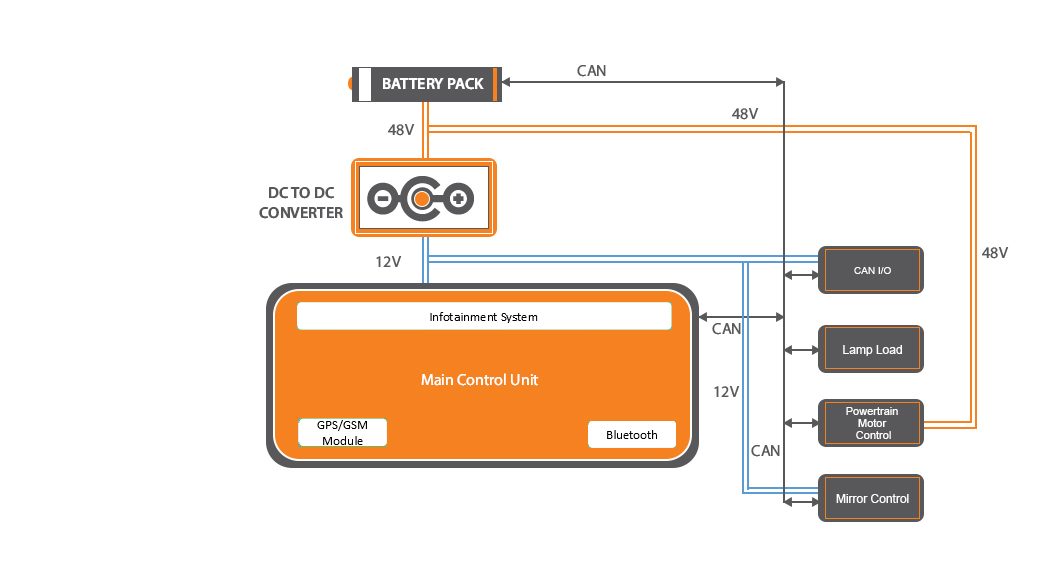In the Automotive Industry, the Electric Avatar of two-wheelers has also started taking the center stage.
As the roads of the Global Cities are becoming busier by the day, an Electric Two Wheeler promises to be a more eco-friendly, sustainable and feasible option for local commute.
To live up to this promise and meet the expectations of digital savvy city commuters, many OEMs’ are supporting Android Infotainment and Telematics related features in Electric Two Wheelers.
In comparison to Electric Cars, though the complexities are drastically different but the common technology thread between them is a humble electronic component known as an Electronic Control Unit.
The Electronic Control Units have made the cars smarter over the years and are facilitating the two-wheelers to become Smart as well.
Several features, widely integrated in four wheelers, are now being made available in two–wheelers as well. These features include engine immobilizers, ABS, Anti-theft alarm and what not! However, as we are focusing on only the electric two-wheelers in the blog, we will stick to a few particular vehicle ECUs critical for the design of an Electric Two-Wheeler.
Since the hardware and software challenges related to two-wheeler architecture design are quite different from that of four wheelers. The in-depth understanding of Control Units and Motor Control Systems becomes an interesting prospect for a budding Automotive Engineer!
However, before we jump to different control systems and their role, here’s a little prelude – we will explore the two possible architecture designs for a networks of ECUs’ in an electric two-wheeler.
Centralized ECU System vs Multiple ECU System
Vehicle ECUs are small computers in themselves which are essential in supporting various product features.
Based on the business objectives and other technical considerations, one can design a system architecture either with single ECU or one with multiple units. We will discuss details of both these designs.
How Single ECU System Architecture Works
Typically, in a single ECU scenario, there is a central Body Control Unit that does all the hard work. It is directly connected to various sensors, collects the required information from sensors and CAN network, does the processing and implements necessary action. This works best when there are not too many sensors are integrated in your product design.
The algorithms required to process the vehicle parameters are ported in the processor of this central control unit. The central Body Control Module (BCM) is connected to sensors through the harness (wires). Functions like DC to DC conversion, drivetrain, lamp load etc. are handled by the main unit.
The following diagram will help you understand the system better.

Pros and Cons of such a system:
Pros:
- As a single ECU is at work, the developers need to devote lesser time for testing the units.
- Fewer Third-party licenses are involved.
- The fault can be easily located because of the centralized design of the architecture.
- Lesser number of ECUs leads to reduced time-to-market and design cost.
Cons:
- Direct connection of a number of Sensors with the central body control unit translates into a complicated set of harnesses which creates complexity.
- Single ECU also means a bigger board that may take up a lot of space.
- A back-up unit (Redundant system) is required as a fault in the Main ECU can have a far-reaching impact. This again translates into cost overhead.
How a Multiple ECUs Architecture System works
Having a more decentralized architecture, this system has multiple ECUs which are tasked to manage different functions. However, each of them is interfaced with the main control unit, called the body control module.
So there is a separate control unit for powertrain motor control system, CAN input/output, headlight, infotainment system and so on. These ECUs are connected to the respective sensors in order to fetch the required information.
For instance, the infotainment ECU will fetch the wheel speed, engine speed etc. and display them on the screen. Another ECU may read the level of the fuel in the tank and calculate the distance-to-empty using an algorithm.
The blog diagram will make it easier to comprehend.

A separate control unit for different functions helps in de-cluttering the entire system. However, there may be a few downsides too. Let’s examine both!
Pros:
- Control processor (Main Control Unit) will perform only the computation and this helps in boosting the overall performance of the system.
- Complexity of the harness (wiring) coming to the body control module will be reduced.
- In case of a fault in one control unit, there won’t be an impact on the other units to a large extent.
Cons:
- More ECUs would mean escalated cost, thus making vehicle more expensive.
- Different control units would need to be tested separately; Impact- More turn-around time and increased development cost.
- Several 3rd party licenses may be required, when we use vehicle ECUs from different vendors.
All said and done, multiple ECUs would still be recommended if you are building a futuristic, feature-rich electric two-wheeler that’s not just efficient but also smart and intuitive.
Now that we know about both the centralized ECU system as well as the multiple ECUs scenario, it’s time to learn about different ECUs at work in an electric two–wheeler.
Some Commonly Deployed Electronic Control Units in Electric Two-Wheelers
- DC to DC Converter: This ECU is essentially the power regulator. Different vehicle ECUs may have different power requirements.The powertrain ECU is likely to have a requirement of more power as it has to move the vehicle wheels. A headlight ECU on the other hand will have lesser voltage requirement than what the battery is providing. But, the battery pack always delivers a fixed voltage.The DC to DC converter can buck and boost i.e. reduce or amplify this power. The voltage then goes to the respective ECUs depending on their voltage requirement over the wiring harness.As a matter of fact, there can be multiple DC to DC converter ECUs as well. A few ECUs that require some specific operating voltage have separate converters.
- Battery Management System ECU: Unlike IC engines, where a lot goes inside an engine, an electric engine is quite straightforward. You have a battery pack and an induction motor that drives the wheel (powertrain). The challenge here is to manage the battery so as to make the powertrain system efficient.Typically, a BMS will have algorithms to control the current during charging state, estimation of the battery state, cell balancing and various other activities. As battery is an electrochemical product, it is important to protect it from adverse environmental and operational conditions as well.If there is any kind of inconsistency in the performance of the batteries, it can affect the functions that rely on the battery pack for optimized power. The role of BMS is also to continuously monitor the current state of the battery and take measures if any malfunction occurs.This requires the BMS to acquire vehicle’s parameters from other automotive control units as well like thermal sensors, voltage sensors and others.
- Powertrain ECU: This is the core electric two- wheeler ECU that is directly responsible for the running of the vehicle. It houses the motor control system that takes the power from the battery, makes adjustments, and transfers it to the actual AC induction motor that drives the wheel.In an Internal Combustion engine, the speed of the vehicle is regulated by controlling the amount of fuel mixed with air.On the other hand, in an electric engine the powertrain ECU is tasked with this responsibility. With the help of a complex motor control system, it alters the Pulse Width Modulation (PWM) of the current for controlling the speed.
- Body Control Unit: This is the big daddy of all small ECUs in an electric vehicle. It takes input from different ECUs and also monitors ECUs’ over a CAN network.Apart from that, Body Control Unit may have to manage some set of dedicated functions. This varies from OEM to OEM, but the body control unit may be tasked with management of the infotainment system, roll back control, battery control unit etc.In a centralized ECU system, this body control unit takes vehicular data directly from the sensors. However, in a multiple ECU setting, it is connected to separate ECUs over vehicle network.In addition to these core control units, there are several small ECUs that perform some specific functions. For instance, CAN BUS I/O ECU will take care of all the inputs and outputs over the CAN BUS.The lamp load ECUs will control the head-light, indicator light, brake lights and so on. A mirror control unit may be there to control the side view mirror with the help of a dedicated motor control system.
Conclusion
In the future, we may see more automotive ECUs making your electric two- wheeler, a powerhouse of amazing features and at the same time, safe and efficient. Watch for this space for more such blogs on innovations in electric two-wheelers.




